In this Tuesday, Dec. 10, 2019 photo, World War II and Battle of the Bulge veteran Arthur Jacobson, from Port St. Lucie, Florida, poses in front of a World War II vehicle at the Remember Museum 39-45 in Thimister-Clermont, Belgium. It was 75 years ago that Hitler launched his last desperate attack to turn the tide for Germany in World War II. At first, German forces drove so deep through the front line in Belgium and Luxembourg that the month-long fighting came to be known as The Battle of the Bulge. When the Germans asked one American commander to surrender, the famous reply came: 'Nuts!" By Christmas, American troops had turned the tables on the Germans. Veterans are heading back this weekend and on Monday, Dec. 16, 2019 when they will mix with royalty and dignitaries to mark perhaps the greatest battle in U.S. military history. (AP Photo/Virginia Mayo)
The Associated Press
BASTOGNE, Belgium (AP) - Pvt. Arthur Jacobson was seeking cover in the snow behind a tank moving slowly through the wooded hills of Belgium's Ardennes, German bullets whizzing by.
That was when he lost his best friend and Bazooka team partner to sniper fire. 'œThey couldn't hit him, he shouted," Jacobson said wistfully. 'œThose were his last words.'ť
The recollection of his worst day in the Battle of the Bulge still haunts him, three quarters of a century later during the first return of the 95-year-old to the battlefield.
And at a time when U.S. President Donald Trump is fanning the flames of trans-Atlantic discord, the pristine-white rows of thousands of grave markers over the remains of U.S. soldiers in cemeteries on the former front line hark back to the days when Americans made the ultimate sacrifice for a cause across the ocean.
The fighting in the bitterly cold winter of 1944 was unforgiving to the extreme.
What Jacobson didn't know then was that he was part of the battle to contain Nazi Germany's desperate last offensive that Adolf Hitler hoped would become his version of the Allies' D-Day: A momentous thrust that would change the course of World War II by forcing U.S. and British troops to sue for peace, thus freeing Germany to focus on rapidly advancing Soviet armies in the east.
'œWE WERE THERE TO DO SOMETHING ABOUT IT"
The Battle of the Bulge "is arguably the greatest battle in American military history,'ť according to the U.S. army historical center. Such perspective came only later to Jacobson, who was barely 20 at the time.
'œThey really didn't tell us anything," he said . "The Germans had attacked through Belgium, and we were there to do something about it.'ť
Out of the blue at dawn on Dec. 16, 1944, over 200,000 German troops counter-attacked across the front line in Belgium and Luxembourg, smashing into battle-weary US soldiers positioned in terrain as foreign to them as it was familiar to the Germans.
Yet somehow, the Americans blunted the advance and started turning back the enemy for good, setting allied troops on a roll that would end the war in Europe less than five months later.
This battle gained fame not so much for the commanders' tactics as for the resilience of small units hampered by poor communications that stood shoulder to shoulder to deny Hitler the quick breakthrough he desperately needed. Even though the Americans were often pushed back, they were able to delay the German advance in its crucial initial stages. The tipping point was to come later.
All weekend, a handful of returning veterans like Jacobson will be feted by an ever grateful local population for their bravery. Royalty, dignitaries and some government leaders will gather in Bastogne, Belgium and Hamm, Luxembourg, on Monday to remember the battle itself. 'œIt will be a great day,"" said Belgian Vice Premier Koen Geens. Remembering both the German forces, driven on by Hitler's hated SS troops, and the allied soldiers, he said: 'œ'ťWe are capable of the worst and of the best.""
'œI DON'T NEED A NECKTIE"
Overall, deaths in the month-long battle are estimated in the five digits. The Americans suffered at least 80,000 casualties including more than 10,000 dead, while up to 12,000 were listed killed among some 100,000 German casualties.
Among the fallen was Albert W. Duffer, Jacobson's Bazooka team partner, shot in the neck by a German sniper on Jan. 6, 1945. Last Tuesday Jacobson went to greet Duffer for the first time in 75 years - at the Henri Chapelle U.S. cemetery in the northern part of the battle zone, where 7,987 U.S. soldiers lie buried. At dusk, Jacobson watched the U.S. flag being lowered and was presented with it in recognition of his valor.
The Battle of the Bulge was one of the war's least predictable campaigns. After D-Day and the draining Normandy drive, allied troops sweeping across the continent believed the worst was behind them.
Paris had been liberated, Gen. George Patton was moving eastwards toward Germany, and Hitler had to keep an increasingly bleary eye on Stalin's Soviet armies advancing on the Eastern Front.
'œThe thought was that Germany was on its knees and could no longer raise a big army,'ťsaid Mathieu Billa, director of the Bastogne War Museum.
Still, Hitler believed Germany could turn the tide, and centered on regaining the northern Belgian port of Antwerp with a push through the sparsely populated Ardennes.
The 120-mile (170 kilometer) dash seemed so fanciful that few of Hitler's own generals believed in it, let alone the allied command. Allied intelligence heard something might be afoot, but even on the eve of the attack the U.S. VIII Corps daily note said that "There is nothing to report."
For days to follow, the only reports would be bad for U.S. troops retreating amid word that SS troops were executing their prisoners - like at Malmedy, where 80 surrendered soldiers were murdered in a frozen field.
When Jacobson moved into the Ardennes, night temperatures outdoors dropped as low as -20 Celsius (-4 Fahrenheit). 'œ'ťYou had to dance around not to freeze to death," he said. Daytime saw the constant fear of sniper fire.
Back home in the States, some were oblivious to the soldiers' plight. 'œMy family sent me a necktie," Jacobson chuckled. 'œI sent a letter back: '~I don't need a necktie'."
'œNUTS!"
Soon though, the German effort pushed its limits as Antwerp remained well out of reach and troops ran out of ammunition, morale and, crucially, fuel. Even the weather turned against the Germans, as the skies finally cleared, allowing the all-powerful allied air force to pound the enemy.
Nowhere was that tipping point more visible than in the southern Ardennes town of Bastogne, where surrounded U.S. troops were cut off for days with little ammunition or food.
When Brig. Gen. Anthony C. McAuliffe of the 101st Airborne received a Dec. 22 ultimatum to surrender or face total destruction, he offered one of the most famous - and brief - replies in military history: 'œ'ťNuts.""
Four days later, Patton's troops broke the encirclement. And so it went with the Battle of the Bulge too, with the U.S. troops gaining momentum after Christmas.
After the fighting ended on 28 January 1945, Allied forces invaded Germany, eventually leading to the Nazi surrender and the end of the war in Europe.
Jacobson, who lives in Port St. Lucie, Florida, also entered Germany. But his war was ended by a March 2 mortar blast, which seriously injured his leg and killed three other soldiers.
After eight months of front-line horror, hospital offered him a kind of deliverance despite the pain.
'œI used to wake up at night in the hospital. I'd dream about having to move out at night," he said. 'œOrders would come down, '~let's move out to another position.' And I'd wake up," he said, 'œand look around and see where I was and then smile to myself and go back to sleep.'ť
___
AP photojournalist Virginia Mayo and videojournalist Mark Carlson contributed to this story
In this Tuesday, Dec. 10, 2019 photo, World War II and Battle of the Bulge veteran Arthur Jacobson, from Port St. Lucie, Florida, writes his name and unit name inside the back of a World War II vehicle at the Remember Museum 39-45 in Thimister-Clermont, Belgium. It was 75 years ago that Hitler launched his last desperate attack to turn the tide for Germany in World War II. At first, German forces drove so deep through the front line in Belgium and Luxembourg that the month-long fighting came to be known as The Battle of the Bulge. (AP Photo/Virginia Mayo)
The Associated Press
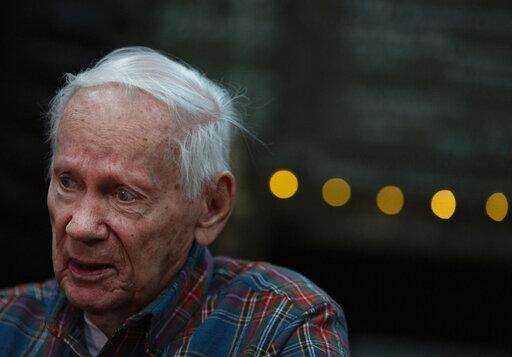
In this Tuesday, Dec. 10, 2019 photo, World War II and Battle of the Bulge veteran Arthur Jacobson, from Port St. Lucie, Florida, speaks with a journalist during an interview with the The Associated Press at the Remember Museum 39-45 in Thimister-Clermont, Belgium. It was 75 years ago that Hitler launched his last desperate attack to turn the tide for Germany in World War II. At first, German forces drove so deep through the front line in Belgium and Luxembourg that the month-long fighting came to be known as The Battle of the Bulge. (AP Photo/Virginia Mayo)
The Associated Press

In this Jan. 6, 1945 file photo, American tanks wait on the snowy slopes in Bastogne,Belgium. It was 75 years ago that Hitler launched his last desperate attack to turn the tide for Germany in World War II. At first, German forces drove so deep through the front line in Belgium and Luxembourg that the month-long fighting came to be known as The Battle of the Bulge. When the Germans asked one American commander to surrender, the famous reply came: 'Nuts!" By Christmas, American troops had turned the tables on the Germans. Veterans are heading and on Monday, Dec. 16, 2019 when they will mix with royalty and dignitaries to mark perhaps the greatest battle in U.S. military history. (AP Photo, File)
The Associated Press
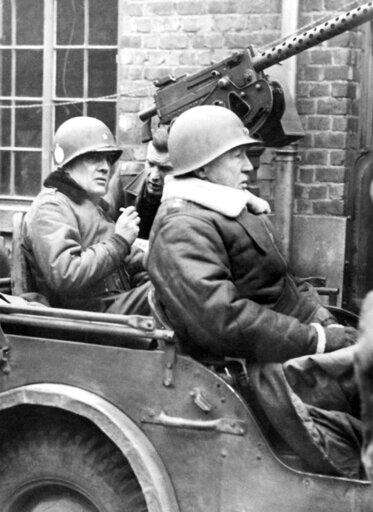
FILE - In this Jan. 15, 1945 file photo, U.S. Brig. Gen. Anthony C. McAuliffe, left, and Lt. Gen. George S. Patton, Jr., right, are seated in Jeep after made an inspection tour of the 101st Airborne division. At first, German forces drove so deep through the front line in Belgium and Luxembourg that the month-long fighting came to be known as The Battle of the Bulge. When the Germans asked one American commander to surrender, the famous reply came: 'Nuts!" By Christmas, American troops had turned the tables on the Germans. Veterans are heading and on Monday, Dec. 16, 2019 when they will mix with royalty and dignitaries to mark perhaps the greatest battle in U.S. military history. (AP Photo, File)
The Associated Press
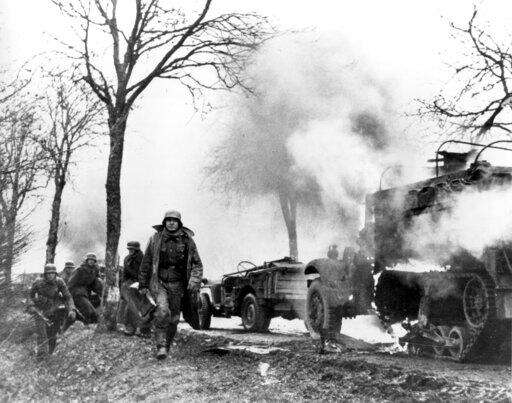
FILE - In this Dec. 1944 file photo, German infantrymen pass by burning captured American vehicles during the drive into Allied lines on the Western Front during the Battle of the Bulge. It was 75 years ago that Hitler launched his last desperate attack to turn the tide for Germany in World War II. At first, German forces drove so deep through the front line in Belgium and Luxembourg that the month-long fighting came to be known as The Battle of the Bulge. When the Germans asked one American commander to surrender, the famous reply came: 'Nuts!" By Christmas, American troops had turned the tables on the Germans. Veterans are heading and on Monday, Dec. 16, 2019 when they will mix with royalty and dignitaries to mark perhaps the greatest battle in U.S. military history. (AP Photo, File)
The Associated Press

FILE - In this Jan. 1945 file photo, American soldiers check for identification on the bodies of dead U.S. troops shot by German troops near Malmedy, Belgium during World War II's Battle of the Bulge. It was 75 years ago that Hitler launched his last desperate attack to turn the tide for Germany in World War II. At first, German forces drove so deep through the front line in Belgium and Luxembourg that the month-long fighting came to be known as The Battle of the Bulge. When the Germans asked one American commander to surrender, the famous reply came: 'Nuts!" By Christmas, American troops had turned the tables on the Germans. Veterans are heading and on Monday, Dec. 16, 2019 when they will mix with royalty and dignitaries to mark perhaps the greatest battle in U.S. military history. (AP Photo, File)
The Associated Press
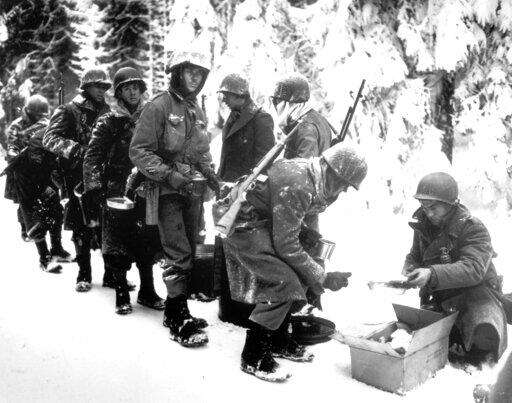
FILE - In this Jan. 13, 1945 file photo, and provided by the U.S. Army, American soldiers of the 347th U.S. Infantry wear heavy winter gear as they receive rations in La Roche, Belgium.It was 75 years ago that Hitler launched his last desperate attack to turn the tide for Germany in World War II. It was 75 years ago that Hitler launched his last desperate attack to turn the tide for Germany in World War II. At first, German forces drove so deep through the front line in Belgium and Luxembourg that the month-long fighting came to be known as The Battle of the Bulge. When the Germans asked one American commander to surrender, the famous reply came: 'Nuts!" By Christmas, American troops had turned the tables on the Germans. Veterans are heading and on Monday, Dec. 16, 2019 when they will mix with royalty and dignitaries to mark perhaps the greatest battle in U.S. military history. (U.S. Army, via AP, File)
The Associated Press
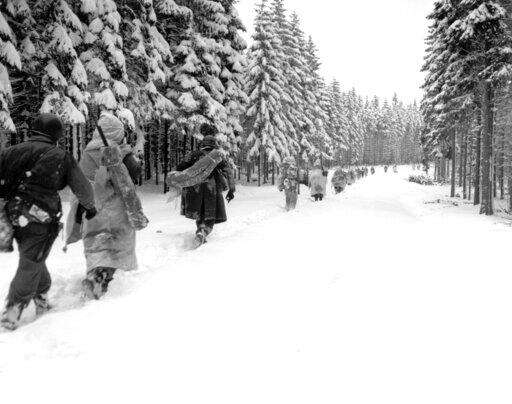
FILE - In this Jan. 28, 1945 file photo, U.S. troops of the 82nd Airborne division travel on a snow-covered fire track in the woods as they move forward in the Ardennes region in Belgium during the Battle of the Bulge. It was 75 years ago that Hitler launched his last desperate attack to turn the tide for Germany in World War II. At first, German forces drove so deep through the front line in Belgium and Luxembourg that the month-long fighting came to be known as The Battle of the Bulge. When the Germans asked one American commander to surrender, the famous reply came: 'Nuts!" By Christmas, American troops had turned the tables on the Germans. Veterans are heading and on Monday, Dec. 16, 2019 when they will mix with royalty and dignitaries to mark perhaps the greatest battle in U.S. military history. (Army Signal Corp via AP, File)
The Associated Press
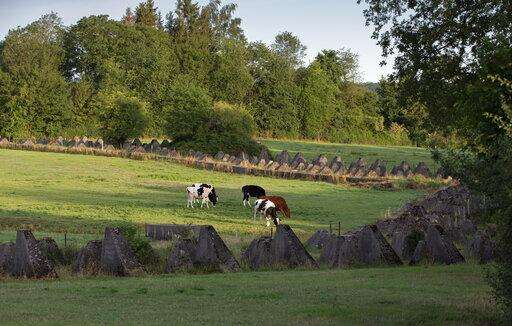
In this photo taken on Aug. 8, 2019, cows graze next to World War II anti-tank obstacles, known as Dragon's Teeth, near Simmerath, Germany. The square-pyramidal fortifications of reinforced concrete were first used by the German Army during World War II to impede the movement of tanks and mechanized infantry. It was 75 years ago that Hitler launched his last desperate attack to turn the tide for Germany in World War II. At first, German forces drove so deep through the front line in Belgium and Luxembourg that the month-long fighting came to be known as The Battle of the Bulge. (AP Photo/Virginia Mayo)
The Associated Press
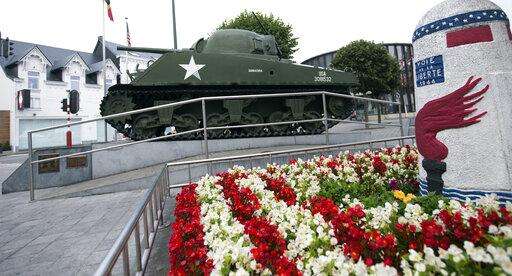
FILE - In this Aug. 29, 2015 file photo, a World War II tank and a marker are surrounded by flowers in the town center of Bastogne, Belgium. It was 75 years ago that Hitler launched his last desperate attack to turn the tide for Germany in World War II. At first, German forces drove so deep through the front line in Belgium and Luxembourg that the month-long fighting came to be known as The Battle of the Bulge. When the Germans asked one American commander to surrender, the famous reply came: 'Nuts!" By Christmas, American troops had turned the tables on the Germans. Veterans are heading and on Monday, Dec. 16, 2019 when they will mix with royalty and dignitaries to mark perhaps the greatest battle in U.S. military history. (AP Photo/Virginia Mayo, File)
The Associated Press
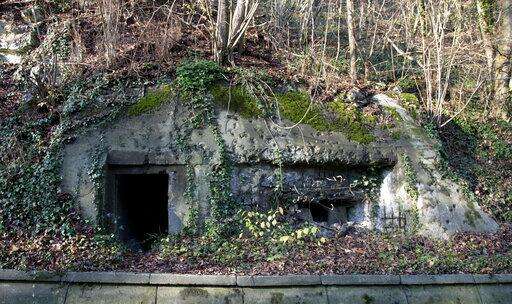
FILE - In this Monday, Dec. 14, 2015 file photo, a World War II bunker is embedded into a hillside above the River Meuse in Lanaye, Belgium. The bunker was used during the war by German troops in the defense of their positions along the river. It was 75 years ago that Hitler launched his last desperate attack to turn the tide for Germany in World War II. At first, German forces drove so deep through the front line in Belgium and Luxembourg that the month-long fighting came to be known as The Battle of the Bulge. (AP Photo/Virginia Mayo, File)
The Associated Press
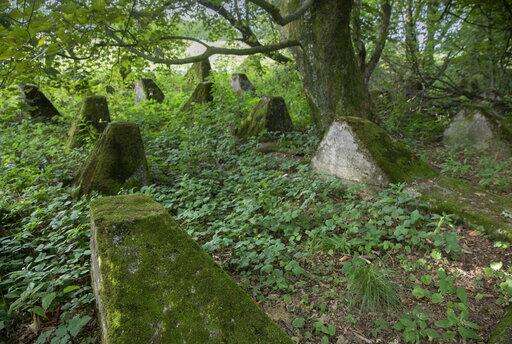
In this photo taken on Aug. 8, 2019, World War II anti-tank obstacles, known as Dragon's Teeth, are covered in moss near Simmerath, Germany. The square-pyramidal fortifications of reinforced concrete first used by the German Army during World War II to impede the movement of tanks and mechanized infantry. It was 75 years ago that Hitler launched his last desperate attack to turn the tide for Germany in World War II. At first, German forces drove so deep through the front line in Belgium and Luxembourg that the month-long fighting came to be known as The Battle of the Bulge. (AP Photo/Virginia Mayo)
The Associated Press

In this photo taken on Aug. 8, 2019, visitors walk among the headstones at the Henri Chapelle World War II cemetery in Henri Chapelle, Belgium. The cemetery contains 7,992 American war dead and covers 57 acres. It was 75 years ago that Hitler launched his last desperate attack to turn the tide for Germany in World War II. At first, German forces drove so deep through the front line in Belgium and Luxembourg that the month-long fighting came to be known as The Battle of the Bulge. (AP Photo/Virginia Mayo)
The Associated Press